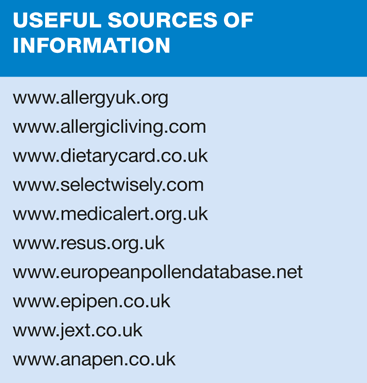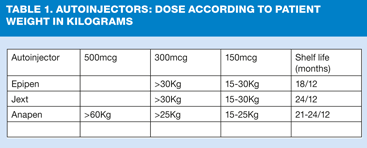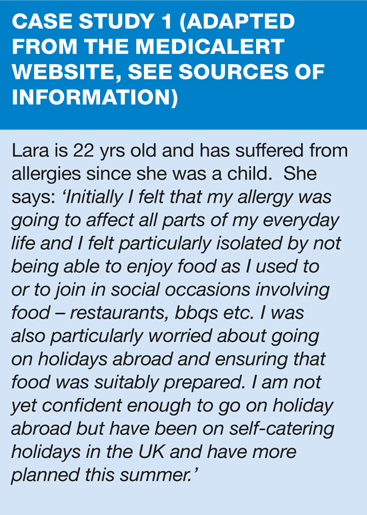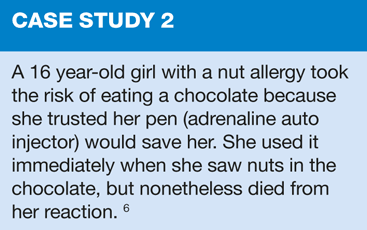Travel medicine: Travelling with allergies
Margaret Umeed, RGN MSc. MFTM (RCPSG) FQNIS
Margaret Umeed, RGN MSc. MFTM (RCPSG) FQNIS
Specialist Nurse Practitioner, Glasgow
Coping with allergies at home is bad enough, although there is much that the practice nurse can do: for those planning to travel, whether on holiday or business, there are special considerations for the travel advisor
Allergy, the body's immune response to a normally harmless substance such as pollen, food or house dust mite (HDM), is common. Around 21 million adults in the UK suffer from allergies: approximately 1:4 of the UK population will suffer from an allergy at some time in their lives and the number is increasing by approximately 5% each year.1 Although allergies can cause minor symptoms such as a runny nose or itchy eyes, severe allergic reactions can result in anaphylaxis and can be life-threatening. Many potential travellers with allergies are discouraged from travelling (see case study 1) but those who do attend for a pre-travel consultation should be appropriately advised. This article attempts to address the top five UK allergies: Pollen, Food, HDM, Pets and Medications, with a travel twist.
POLLEN
Recent research published by Allergy UK2 identified that approximately 15 million Britons suffer from hayfever. Not only were 46% of hayfever sufferers constantly on their guard, 40% said they would avoid places where they could come into contact with the allergen they react to and 15% of sufferers were so affected they felt unable to leave their homes. When travelling abroad the allergenic content of the atmosphere varies according to climate, vegetation and geography. Studies show that the pollen map of Europe is changing, with the introduction of non-native trees such as birch and cypress, colonization of imported 'foreign' vegetation such as ragweed and the ubiquitous climate change. Data on the presence and prevalence of allergenic airborne pollens make it possible to design pollen calendars, and forecast the chances of encountering pollen concentrations in different areas.3 Travellers who suffer from pollen allergies should be encouraged to utilise such sources of information when planning their trips (see sources of information for European pollen database). Travellers should also be encouraged to maximise their allergy therapy prior to travelling in an attempt to control symptoms, and ensure they have sufficient supplies of medicines with them during their trip.
FOOD
Forty percent of hayfever sufferers also react to one or more of nuts, fruits, veg and spices.2 Globally it is estimated that food allergies affect 3.5-4% of the world's population with seafood allergies among the most common.4 Allergic reactions to shellfish i.e. crustaceans and molluscs, can range from mild urticaria and oral allergy syndrome to life threatening anaphylaxis. Tropomyosin, the major shellfish allergen, has been shown to be not only the major allergen involved in cross reactivity between crustaceans and molluscs, but also with other inhaled invertebrates such as HDM and insects.5 Although many food allergy sufferers fear a life threatening anaphylactic reaction, a study of all UK food allergy-related deaths in the UK,6 demonstrated that over half the deaths between 1999-2006 occurred in people whose previous reaction had been so mild that it was unlikely a doctor would have recommended they carry an adrenaline auto injector. Data suggest that the overuse of salbutamol, lack of a daily inhaled corticosteroid and a recent asthma exacerbation might be associated with fatal food reactions, and led the authors to conclude that asthmatics with a food allergy should take extra care if they feel unwell.6 Many sufferers will have been prescribed an adrenaline autoinjector (Table 1), however the authors of the study urged caution on the over reliance of such devices (Case Study 2) and suggested that the effectiveness of self-injectable epinephrine could not be guaranteed and should not be relied upon.6 Travellers should be encouraged to carry a dietary alert card, either in English or translated (see sources of information) and use it whenever eating in restaurants, purchasing supplies in shops, travelling on public transport etc. They should also be aware of the three possibilities of cross contamination: food to food (touching or dripping), food to hand (handling by kitchen staff, waiter or street vendor) and food to equipment (preparing food using non-reserved pots and utensils), and be aware of possible reactions to ingredients in exotic dishes.7 Travellers should contact their airline well in advance of travel with specific food requests and this would provide an opportunity to clarify the airline's policy in relation to serving nuts as snacks. In one study, 9% of adults with a severe nut or seed allergy reported an allergic reaction, some severe and life threatening, whilst flying.8 Having an anaphylactic reaction at 34,000 feet has obvious implications for the person's emergency treatment and should be avoided where possible. The same study found that individuals regularly did not advise their airline about their allergy and the provision of allergy information from several airlines' customer services, was variable and often incomplete or inaccurate.8
HDM/INSECTS
HDM and insects are important sources of indoor allergens. Studies have shown that hotels, whether 1 star or 5 star, can be an important reservoir for indoor allergens such as HDM and could therefore represent an allergy risk to previously sensitized guests, especially those with a respiratory allergy.9 Bee, wasp and ant (hymenopteran) stings may cause allergic reactions for a third of those stung: a third of whom will have a prior allergy history. The onset of anaphylaxis is usually rapid: 70% occurs within 20 minutes and 90% within 40 minutes: and it is estimated that up to a quarter of sudden outdoor deaths may be as a result of unrecognised anaphylactic reactions to hymenopteran stings. International travellers who intend to spend considerable time outdoors in temperate climates from Spring to Autumn, or in tropical climates all year round, are at significantly increased risk of hymenopteran stings and subsequent allergic reactions. Healthcare professionals should be mindful that there is some evidence that the use of an ACE inhibitor in allergy sufferers may result in a potentially life threatening allergic reaction to a sting.10
PETS
Coming in at Number 4 on the Top 10 list of Allergies in the UK, allergy to animals is estimated at 1 in 10 globally.11 An important consideration for those travelling with allergies is the presence of pets on planes. Although uncommon in the UK, several airlines worldwide allow pets to travel with their owners in the cabin of the plane. One Canadian airline reportedly has pets on 25% of their flights.11 This has obvious implications for those travellers who have an animal allergy. One study demonstrated cat allergen on domestic aircraft seats in sufficient quantities to precipitate an asthma attack12 and there have been several reports of severe asthma attacks following flights, often requiring hospitalisation.11 Travellers should check when booking flights that no pets are allowed in the cabin.
MEDICATIONS
Genuine drug allergy is relatively uncommon. As travel advisors, our main concern is with vaccine reactions, especially anaphylaxis, following immunisation. Fortunately this is extremely rare. A study looking at vaccinating 'allergic' travellers over a ten-year period, had only one episode of anaphylaxis post immunisation, in someone with no previous history of vaccine allergy.13 During 59 patient encounters (there were 38 patients in total referred to the clinic), there were six adverse drug reactions (ADRs), three were local reactions, one involving urticaria, one vasovagal episode (often confused with anaphylaxis) and one anaphylactic episode. The authors concluded that the vast majority of immunisations are uncomplicated, and patients with a history of allergic reactions to vaccinations may be vaccinated safely in a controlled setting.13 It is important to remember however, that true egg allergy is a contraindication when considering yellow fever vaccine,14 and travellers for whom this is absolutely essential should be referred to secondary care for immunisation. ACE inhibitor drugs have already been mentioned as being implicated in hymenopteran stings. Stevens Johnson Syndrome has been implicated with numerous drugs including Fansidar (sometimes used as a treatment for malaria in countries outside the UK), tetracyclines (e.g. doxycyline used as a malaria chemoprophylaxis) and ciprofloxacin (used routinely as a treatment for Travellers' Diarrhoea).15
OTHER ALLERGENS
Skin allergy is not listed in the top five UK allergies but can potentially cause issues. Skin eruptions can be caused by a variety of allergens including sun (polymorphic light eruption [PLE]) and contact with irritants such as Indian Henna (mehndi) and temporary tattoos. Travellers who are known to suffer from PLE should be advised to cover up where possible and use a high factor sun protection (SPF >30) with a UVA and UVB filter on exposed areas of skin. A topical steroid cream and oral antihistamine may help with the inflammation and itch should a rash develop.1The other allergen worth noting is Florida red tide. Florida red tides are naturally occurring marine algae that produce natural toxins called brevetoxins. Inhalation of the aerosolized toxins results in upper and lower airway irritation. Symptoms include eye, nose and throat irritation, coughing, wheezing, chest tightness and shortness of breath and have been noted both in people exposed following a beach walk, and while on board a sailing trip.16,17 People with asthma, not surprisingly, seem to be more adversely affected and should be advised to take inhaled medication as prescribed, and to ensure they have a supply of their usual reliever inhaler with them at all times.
CONCLUSION
Travelling with allergies can be a daunting prospect but with a little preparation, it is possible to make a trip safely. Travellers need to approach airlines well in advance of their proposed trip to confirm there are no pets in the cabin and to make dietary requests. Comprehensive medical travel insurance is essential and should cover all allergies. A MedicAlert emblem provides instant information about the traveller's health issues/allergies and a 24 hour/365 days a year emergency contact for medics. Finally, as travel advisors it is our remit to provide tailored information and advice to those identified at being at risk from allergy, during a pre-travel risk assessment (see top tips and sources of information). Allergy UK provides an extensive range of pdf information leaflets for sufferers, and should be the first port of call before leaving the UK. Conflict of Interest: the author has previously been a member of both the Sanofi Travel Health Vaccine and the GSK Hepatitis B Advisory Boards and has accepted honoraniums from both Sanofi Pasteur MSD and GSK
REFERENCES
1. Allergy UK. Allergy information pages. 2012. Available at: www.allergyuk.org [Accessed: 9 May 2012]
2. Allergy UK. An Apple a Day won't keep the Hayfever Away. 2012. Available at: www.allergyuk.org [Accessed: 9 May 2012]
3. D'Amato G, Cecchi L, Bonini S, et al. Allergenic pollen and pollen allergy in Europe. Allergy. 2007;62(9):976-90.
4. Taylor SL. Mollusc and Shellfish Allergy. Adv Food Nutr Res. 2008;54:139-77.
5. Lopata AL, O'Hehir RE, Lehrer SB. Shellfish Allergy. Clin Exp Allergy. 2010;40(6):850-8.
6. Pumphrey RSH, Gowland MH. Further fatal allergic reactions to food in the UK, 1999-2006. Journal of Allergy and Clinical Immunology. 2007;119(4):1018-9
7. Dietary Card. Top Ten Tips for Tenacious Travellers. 2012. Available at: www.dietarycard.co.uk [Accessed: 9 May 2012]
8. Comstock SS, DeMera R, Vega LC, Boren EJ, Deane S, Haapanen LA, Teuber SS. Allergic reactions to peanuts, tree nuts, and seeds aboard commercial airliners. Ann Allergy Asthma Immunol. 2008;101(1):51-6.
9 Simplicio EC, Silva DA, Braga IA, et al. Mite and pet allergen exposure in hotels in Uberlandia, Midwestern Brazil. Indoor Air. 2007;17(4):278
10. Diaz JH. Recognition, Management, and Prevention of Hymenopteran Stings and Allergic Reactions in Travelers. Journal of Travel Medicine. 2009;16(5):357-364.
11. Stanbrook MB, Kovesi T, Hebert PC. Pets in Airplane Cabins: an unnecessary allergic hazard. Canadian Medical Association Journal (CMAJ) 2010;182(5):421.
12. Martin IR, Wickens K, Patchett K, et al. Cat allergen levels in public places in New Zealand. New Zealand Medical Journal. 1998;111(1074):356-8.
13. McCallum AD, Duncan CJ, MacDonald R, Jones ME. A decade of vaccinating allergic travellers: a clinical audit. Travel Medicine & Infectious Diseases. 2011:9(5):231-7
14. Salisbury D, Ramsay M, Noakes K [eds.] (updated online 26 March 2012) Immunisation against infectious disease. Department of Health, London, 2006. Available at: http://www.dh.gov.uk [Accessed: 10 May 2012].
15. Millikan LE. Life-threatening dermatoses in travellers. Clinics in Dermatology. 2005;23:249-253.
16. Milian A, Nievenberg K, Fleming LE, et al. Reported Respiratory Symptom Intensity in Asthmatics during exposure to Aerolised Florida Red Tide Toxins. Journal of Asthma. 2007;44(7):583-87.
17. Steensma DP. Exacerbation of asthma by Florida "Red Tide" during an ocean sailing trip. Mayo Clinic Proceedings. 2007;82(9):1128-30.
Related articles
View all Articles




